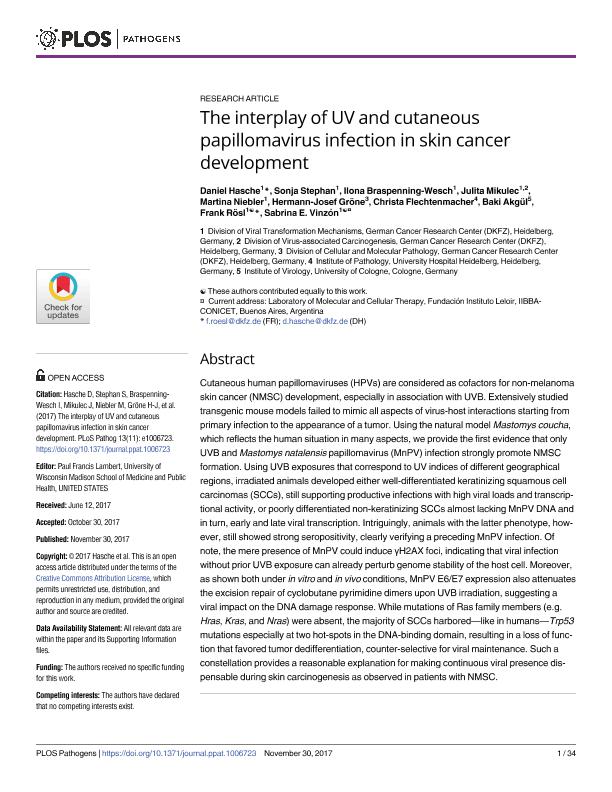Artículo
The interplay of UV and cutaneous papillomavirus infection in skin cancer development
Hasche, Daniel; Stephan, Sonja; Braspenning Wesch, Ilona; Mikulec, Julita; Niebler, Martina; Gröne, Hermann Josef; Flechtenmacher, Christa; Akgül, Baki; Rösl, Frank; Vinzon, Sabrina Eugenia

Fecha de publicación:
11/2017
Editorial:
Public Library Of Science
Revista:
PLoS pathogens
ISSN:
1553-7374
Idioma:
Inglés
Tipo de recurso:
Artículo publicado
Clasificación temática:
Resumen
Cutaneous human papillomaviruses (HPVs) are considered as cofactors for non-melanoma skin cancer (NMSC) development, especially in association with UVB. Extensively studied transgenic mouse models failed to mimic all aspects of virus-host interactions starting from primary infection to the appearance of a tumor. Using the natural model Mastomys coucha, which reflects the human situation in many aspects, we provide the first evidence that only UVB and Mastomys natalensis papillomavirus (MnPV) infection strongly promote NMSC formation. Using UVB exposures that correspond to UV indices of different geographical regions, irradiated animals developed either well-differentiated keratinizing squamous cell carcinomas (SCCs), still supporting productive infections with high viral loads and transcriptional activity, or poorly differentiated non-keratinizing SCCs almost lacking MnPV DNA and in turn, early and late viral transcription. Intriguingly, animals with the latter phenotype, however, still showed strong seropositivity, clearly verifying a preceding MnPV infection. Of note, the mere presence of MnPV could induce γH2AX foci, indicating that viral infection without prior UVB exposure can already perturb genome stability of the host cell. Moreover, as shown both under in vitro and in vivo conditions, MnPV E6/E7 expression also attenuates the excision repair of cyclobutane pyrimidine dimers upon UVB irradiation, suggesting a viral impact on the DNA damage response. While mutations of Ras family members (e.g. Hras, Kras, and Nras) were absent, the majority of SCCs harbored-like in humans-Trp53 mutations especially at two hot-spots in the DNA-binding domain, resulting in a loss of function that favored tumor dedifferentiation, counter-selective for viral maintenance. Such a constellation provides a reasonable explanation for making continuous viral presence dispensable during skin carcinogenesis as observed in patients with NMSC.
Palabras clave:
Papillomavirus
,
Mastomys Coucha
,
Non-Melanoma Skin Cancer
,
Uv
,
Dedifferentiation
Archivos asociados
Licencia
Identificadores
Colecciones
Articulos(IIBBA)
Articulos de INST.DE INVEST.BIOQUIMICAS DE BS.AS(I)
Articulos de INST.DE INVEST.BIOQUIMICAS DE BS.AS(I)
Citación
Hasche, Daniel; Stephan, Sonja; Braspenning Wesch, Ilona; Mikulec, Julita; Niebler, Martina; et al.; The interplay of UV and cutaneous papillomavirus infection in skin cancer development; Public Library Of Science; PLoS pathogens; 13; 11; 11-2017; 1-34; e1006723
Compartir
Altmétricas



